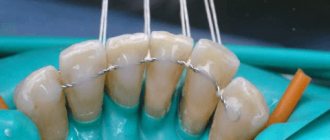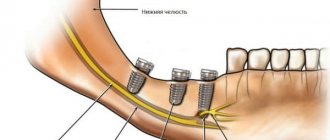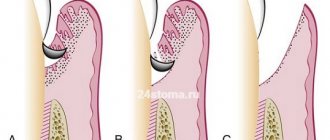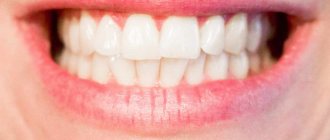Recession is a pathological process of loss of gum volume. Its height is reduced, exposing the neck and beginning of the tooth root.
During a recession, the smile turns out to be ugly, but this is not only a cosmetic defect. The enamel in the root zone is thinner and more sensitive, so physiologically it should be covered by the mucous membrane. Against the background of gum recession, increased sensitivity of the teeth develops, and there is a higher risk of the spread of infections, the development of caries and pulpitis.
Gum recession cannot be cured on its own; a doctor must identify the cause of the pathology and prescribe treatment. Our clinic’s specialists are proficient in modern diagnostic and treatment methods, and advanced equipment allows us to restore lost gum tissue in the shortest possible time.
What is a recession
Gum loss is not an independent disease, but a consequence of pathological processes developing in the body: injuries, diseases or age-related changes.
The gums are a dense part of the oral mucosa; the interdental papillae that separate the root zone are covered with stratified epithelium. This allows you to preserve, nourish and securely hold the roots of your teeth.
The gums should cover the neck of each tooth. With age or due to the wrong development of events, the gums wear out and no longer protect the fragile tooth roots.
Recession can develop on 1-2 teeth or cover the entire dentition. This is a systemic (generalized) recession.
My gums hurt and are swollen, what should I do?
If you start to feel pain in your gums, you shouldn’t hope that maybe it will go away on its own; hurry up and see a doctor. It is he who will understand the reason that caused the development of inflammation. Determines the degree of the inflammatory process. Once diagnosed, treatment is very effective and you will soon feel healthy again.
For prevention purposes, we recommend choosing the right brush and toothpaste according to the condition of your teeth and gums. For example, sensitive gums are further damaged by hard bristles, so it is better to choose a brush with soft bristles. It is necessary to practice oral hygiene at least 2 times a day – in the evening and in the morning.
If you follow the recommendations described above, both your teeth and gums will not cause you any discomfort.
What causes a defect?
The causes of gum loss can be divided into 3 groups:
- Traumatic . If the gums are rubbed by a poorly installed filling, crown or teeth in the area of malocclusion, the gums will gradually atrophy and shrink. Recession is caused by shocks and injuries, exposure to harmful substances, poor ecology, and bad habits. Pathology can develop due to incorrectly performed whitening - in the clinic or at home, or aggressive brushing with a hard toothbrush. Large, incorrectly made veneers also often lead to gum recession.
- Symptomatic. It may be a consequence of gum disease or metabolic disorders, disturbances in the functioning of the endocrine or hematopoietic systems.
- Physiological . The reason is the aging of the body and metabolic disorders.
Saying goodbye to gum pain
If your gums are sore and swollen, what should you do first? No, don’t use a plot from your mother’s best friend’s neighbor’s great-grandmother. All “spells” for dental problems are in the hands of the dentist, and only he knows how to correctly “spell” gums from pain and bleeding.
Inflammatory processes occurring in the teeth and gums in the case of periodontitis and gingivitis are provoked, as already mentioned, by bacteria colonizing tartar. So, if you notice that your gums are swollen, what should you do with your right mind? That's right - remove stone deposits from teeth. Unfortunately, no toothbrush can “overpower” tartar plaque, so you need to go to the clinic for professional teeth cleaning. Only when the teeth are cleared of all deposits will therapeutic treatment be prescribed, including antibiotics, if the complexity of the case requires it.
Don’t ask about advanced inflammation: this is only a matter for the dentist. You can treat inflammation yourself only in the initial stages; it includes rinsing the teeth with a chlorhexidine solution and treating with cholisal gel.
The course is usually designed for 10 days. Procedures must be carried out after meals in the morning and evening. Such rinses are quite effective when the case is not advanced.
If your gums hurt not because of mild inflammation, but because of the development of severe and moderate periodontitis, then the treatment process will be different.
Periodontitis is the development of an inflammatory process at the apex of the tooth root, which leads to a periodontal abscess - the formation of a dental cyst - a sac of pus that can burst and leave a fistula opening. Under such circumstances, pain in the gums can be caused by caries or pulpitis. How to treat gums with periodontitis? Treatment in this case will consist of:
- removal of carious areas of dental tissue;
- nerve removal;
- treatment of root canals with medicinal paste and temporary filling;
- removal of stones;
- anti-inflammatory therapy of a general or local nature.
How to identify the problem - symptoms of the disease
Even in the initial stage, a recession is visually noticeable. Smile in front of the mirror so that your gums are visible, pay attention to whether the dentition is uniform relative to its position in the gum. Loss of tissue can occur on 1-2 roots of the tooth; in these places the tooth will look longer. And at its base an additional defect will appear in the form of a drop or wedge.
As the disease progresses, the following symptoms appear:
- inflammation, redness, swelling of the gums;
- the roots of nearby teeth are exposed;
- cracks appear between the roots, expanding as the defect develops;
- pain when eating spicy, sour, cold or hot food, or when inhaling cold air. In the future, it will be painful for the patient to chew even soft food; unpleasant sensations will arise with light contact with the lips and cheeks.
The pain occurs because the layer of enamel on the exposed roots is thinner, which increases their sensitivity. In addition, when the cervical area is open, it is susceptible to attack by pathogenic bacteria. This means that caries will develop faster.
What are the possible consequences and complications of the pathology?
If gum recession is not treated, it is likely to develop:
- hyperesthesia - increased painful sensitivity to external stimuli;
- caries;
- pulpitis;
- violation of smile aesthetics.
An advanced recession is more difficult to treat; the rehabilitation process will take several months. Treatment will be more expensive, and several surgical operations may be required.
Types of pathology
There are several classification systems for gum recession. According to the degree of damage, it can be local and generalized, according to the severity of the course it is mild (the roots are exposed by 3 mm), moderate (down to 5 mm) and severe (a deeper process).
Miller's classification identifies four types of gum loss:
- 1 type. The pathological process develops over an arbitrarily wide area, but does not expose the roots.
- 2nd view. The loss extends beyond the natural connection of the tooth to the gum and slightly exposes the roots.
- 3rd view . The roots are slightly open, the bone tissue in the area of the defect is lost.
- 4th view. The interdental papillae descend to the level of the gums of the neck of the teeth and are exposed.
Orthodontic treatment for gum loss
Home / Articles / Orthodontic treatment for gum loss
Gum loss is mostly a pathology of older people, but gum recession can also develop at a younger age. Farida Yusifovna Gasimova, a well-known dentist orthodontist at Millennium Anapa Mayakovsky Dentistry, talks about treatment by an orthodontist against the background of loss of gum tissue.
— Farida Yusifovna, what is the loss of gum tissue and why does this process occur?
— Speaking about the dental classification of gum recession, I want to emphasize that today the definitions differ, the most widely used is the Miller classification, which is used both in Russia and abroad. Miller divides recession into four main forms, differing depending on the depth of tissue loss. The first form is diagnosed with narrow and wide recessions that do not affect the gingival papillae and bone tissue. By gingival papillae we mean triangular areas of gum between the teeth. The lesion is not severe and does not affect the area between the gum and mucosa (mucogingival line). The second form of recession includes lesions that affect the mucogingival line and even cross it. At the same time, the integrity of the bone is not compromised and the appearance of the gingival papillae does not change. If a loss of bone and the height of interdental spaces is diagnosed, the dentist orthodontist Anapa Dentistry Millennium Mayakovsky diagnoses a recession of the third degree. The fourth form includes recessions, which include the symptoms of the first and second forms, while there is a pronounced loss of bone and a significant loss in the height of the interdental papillae. The apical displacement of the gingival margin is called gum recession; this disease is a very serious pathological process in which a decrease in gingival tissue towards the root is diagnosed, which over time leads to a phenomenon such as opening of the neck of the tooth. As has been correctly noted, most often, older patients suffer from gum recession, however, a similar process can occur at any age. The spread of the pathological process has recently occurred as a result of the widespread use of orthodontic devices (braces), an excessively stressful lifestyle of people, and insufficient personal hygiene. In cases of gum recession on the inside of the tooth, the pathological process often remains unnoticed by the person since it does not spoil the smile and does not cause pain. From the outside, recession is immediately noticeable, since it manifests itself externally as a visual lengthening of the tooth in relation to the rest, a disproportionality of the unit. It is important to note the fact that the symptoms of recession are not always obvious to the patient and in many cases only a dentist in Anapa can identify the problem. Therefore, I recommend visiting your dentist regularly for preventive examinations and early detection of dental diseases. The patient may experience discomfort, for example, due to a poorly installed filling or unsuitable crowns, due to gingival inflammation or inflammation of a tooth or joint. Of course, against this background, the process of tissue damage is poorly expressed, and therefore does not attract human attention. What should the patient pay attention to first? Of course, for gingival changes. Minor gingival defects appear in the form of a thin strip and indicate the initial stage of the destructive process. The initial stage is classified when the root is exposed to 3mm. Further, the process actively develops and with exposure of more than 3mm to 5-6mm, the second stage of the pathology is diagnosed. Symptoms of the second stage manifest themselves in the form of large-scale exposure and gum loss, tooth sensitivity noticeably increases. As for the third stage, in this case the clinical picture is pronounced, tooth sensitivity is very high, tissue loss can be more than 5-6mm. A generalized form of the pathological process is diagnosed if several teeth, 4 or more, are affected. Reduction of gingival tissue occurs as a result of orthodontic treatment with a fixed appliance, and in this case only a deterioration in aesthetics is manifested. If gum recession is caused by gum disease, for example, periodontitis, then the manifestations are additional in nature, such as bleeding gums, pain, the formation of periodontal pockets with purulent discharge, a feeling of itching, tingling in the gums, viscosity of saliva, and a characteristic taste in the mouth. The gums change noticeably, becoming red, inflamed, loose, with torn edges. If periodontal disease occurs without inflammation, then the gums have a pale pink color, but recession in this case extends to the entire dentition. What is important to know about gum recession? The disease tends to actively progress and can continue until the tooth is completely exposed.
— What methods are used in the treatment of gum tissue loss?
— The treatment method largely depends on the individual characteristics of the patient, his state of health, and the reasons for the development of recession. It is difficult to say clearly which method is always used. Today, a conservative method of closing gum recession, laser surgery, and the method of directed tissue regeneration are used. If we are talking about the surgical method, then this technique also differs into a single-layer and a two-layer method. Surgery is used when gum recession is caused by improper tooth brushing. The Anapa dentist corrects the teeth brushing technique and applies a periodontal bandage to the affected area, the patient is prescribed medications with a regenerating effect, multivitamins, antiseptics, and herbal preparations. One of the most effective regenerating medicines is the drug Methyluracil; it is often prescribed specifically for gum recession. Among multivitamin complexes, I would highlight the Aevit or Superia complex. Antiseptic treatment can be carried out with chlorhexidine or hydrogen peroxide; as for herbal preparations, infusions of chamomile, sage or rose hips have a good effect. Single-layer surgery includes 5 types, the most commonly used is a coronally positioned flap. This technique involves covering the recession with a piece of gum tissue that is cut out from the area of the recession. Of course, this method is relevant in cases of slight gum recession, when the distance from the edge of the affected area to the mucous membrane does not exceed 4 mm. Other single-layer surgical techniques include double papillary flap, epithelialized connective tissue graft, laterally displaced flap, and semilunar flap. The listed methods are rarely used, since their implementation requires the presence of several factors, which are not always available. In addition, such work requires highly professionalism from the surgeon. Two-layer techniques are carried out in the form of placing a connective tissue graft between the primary flap and the surface of the tooth, which can significantly increase the regenerative properties of the gums, improve the volume of soft tissues and aesthetics, and speed up the wound healing process. Flap operations include the operation according to Raetzke, according to Langer and Langer, according to Bruno. As I already said, closing gum recession is carried out not only with flap operations, but also with other methods. For example, using the method of directed tissue regeneration, when artificial membranes are used to install the transplant site. In addition to the main method of closing gum recession, additional therapy in the form of nutritional medications is prescribed.
— Farida Yusifovna, what causes the loss of gum tissue?
— It is possible to determine gum recession from the outside independently, since the pathology is clearly manifested on the gums. Before starting therapy, the dentist in Anapa conducts a comprehensive diagnosis to identify the cause of gum recession. The Anapa dentist collects data on the health of the patient’s oral cavity, conducts a visual examination, determines the condition of the mucous membrane of the gums, hard tissues of teeth, crowns, dentures, fillings, the condition of the palate, lips, tongue, cheeks. Often, it is difficult to accurately determine the true cause of gum recession, so dentists resort to complex diagnostics that allow them to correctly identify the origins of the pathology. Diagnosis of gum recession includes probing, when the orthodontist in Anapa diagnoses the size of the recession, the presence of periodontal pockets, their depth, and the integrity of the circular ligament of the tooth. In addition, a variety of clinical tests, laboratory tests and radiography are used in the diagnostic process. At the end of the diagnostic stage, the Anapa dentist makes a diagnosis, including the cause of the development of the pathology, provoking factors, the width of the defect, the depth of the lesion, the thickness of the gums, and the form of gum recession according to Miller. Next, a treatment plan is drawn up. I would like to emphasize that gum recession requires an integrated approach, carried out according to a clear treatment plan. Identifying the causes of gum recession makes it possible to eliminate the cause that provokes the pathology, only after which is it possible to effectively treat the tissue. If necessary, gum correction is carried out, and in case of deep damage, the decisive opinion remains with the doctor, since in this case it is not only about aesthetics, but also about the health of the entire oral cavity. For minor defects, the patient can independently decide to correct the affected area of the gum. The most important step before treating recession is the complete elimination of inflammatory processes in the mouth, otherwise the therapy will be ineffective. All dental diseases arise for various reasons, including a combination of different factors. Recession occurs quite often against the background of inflammatory processes in the gums, such as gingivitis, periodontitis, and periodontal disease. A common cause of recession is the patient’s malocclusion, and in this case, recession is not the only consequence of the pathology. Improper brushing of teeth, frequent sucking of objects, age-related tissue changes provoke the occurrence of recession, in addition, the structural features of the oral cavity can provoke recession. Recession can be local, when up to three units of the dentition are affected, or generalized, in which the pathology spreads to all teeth in the row. It is important to note that gum recession must be treated, otherwise severe consequences can occur. For example, if gum recession is caused by injury, then bacterial flora often joins the pathology. Taken together, the result is an active inflammatory process that develops into gingivitis or periodontitis. But, much more often, periodontitis or periodontal disease occurs primarily and as a result of this disease, gum recession appears. It is important to understand that exposure of the roots significantly worsens the condition of the teeth and tissues, and can lead to loss or the need to remove units. The presence of periodontal disease or periodontitis requires complex treatment; the disease does not go away on its own. If you have periodontal disease or periodontitis, it is impossible to effectively carry out orthodontic treatment, prosthetics, install fixed or removable structures, or carry out implantation.
Comprehensive hygiene for 2500 rubles! Air Flow 1000p for patients with braces!
A unique promotion for our regular patients! A set of hygienic procedures (removal of tartar and plaque using Air Flow and ultrasound , scaling, polishing, fluoridation) for regular patients once every 6 months for RUB 3,000!
Air Flow and polishing for only RUR 1,500 for patients with braces!










